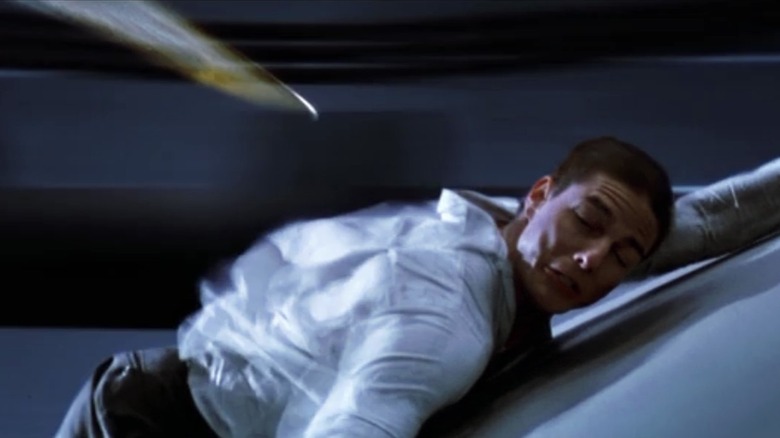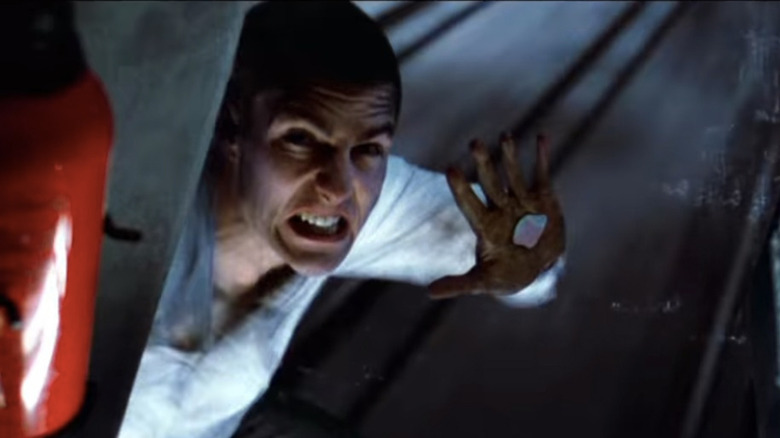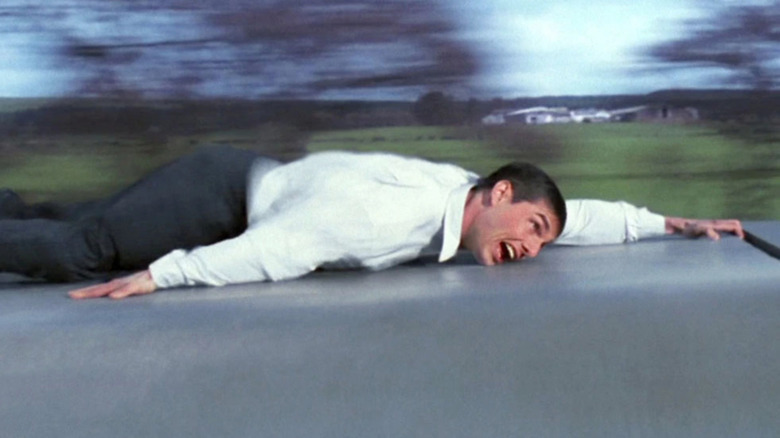How The Mission: Impossible Team Pulled Off The Film's Climactic Train Scene
Up until its climax, Brian De Palma's 1996 film "Mission: Impossible," based on the hit TV series, was a largely quiet, steely affair. While the main character, Ethan Hunt (Tom Cruise) was a man of action, much of "Impossible" was devoted more to heists and stealth than fistfights and explosions. At the film's conclusion, however, Ethan Hunt found himself needing to infiltrate a train that was currently scheduled to zip its way through the Chunnel. The usual set of action movie circumstances forced Ethan to bodily cling to the exterior of the train as it plunged underground. And, just to ensure that the mayhem remains at a high level, a high-speed helicopter flew into the Chunnel behind him. This made for a scene where Ethan Hunt is nearly decapitated by an approaching helicopter blade, as well as a fiery explosion when Ethan mashes explosive chewing gum directly onto the helicopter's windshield. Ethan survived, somehow.
It was a standout sequence from one of the year's more notable hits. According to a documentary interview with VFX Supervisor John Knoll, included as one of the "Mission: Impossible" DVD extras, the helicopter sequence was seven minutes and 20 seconds, and consisted of 152 separate shots. For an action film in 1996, that is the height of enormity. Editing was getting faster and faster, and wild actions were now taking place in fractions of seconds. It's worth noting that Michael Bay's ostentatious action film "The Rock" was in theaters at the same time as "Impossible."
Realizing the train sequence, then, took a lot of planning and storyboarding and pre-composition before a camera could become involved. Each one of those 152 shots had to be planned in advance. This wasn't a freewheeling enterprise. This was a taut affair.
Red light, green light
Like many action sequences, the Chunnel scenes in "Mission: Impossible" began as animatics — that is, pre-visualized mini-movies that use drawings and sometimes models to work out the pacing and music placement in a scene. John Knoll used CGI he learned to develop for "Star Trek: Generations" to make the animatics for "Impossible." The shots were then carefully laid out on a storyboard to let the filmmakers know what and how to film things. Joe Letteri, the film's associate VFX supervisor, described the process thus:
"[W]e have storyboards of the whole sequence to help us understand what we're doing. These evolve from simple animatics to help the director visualize the action to more sophisticated storyboards that were done once we started getting more of the details in place. It helps us to maintain our continuity and to make sure that the story's progressing as it needs to. This train is traveling at speeds upwards of 200 miles per hour with Tom Cruise on top of the train."
Despite the overwhelming volume of action films in the world, there are really only so many ways one can shoot a chase scene. Letteri sensed that some originality would be needed, and that was where the director came in. One can throw helicopters at trains in tunnels all day, but it still needed to be personally directed by a knowing director in order to be interesting. The FX team showed off their toolboxes, and Brian De Palma could extract what he needed. Letteri explained:
"People have seen helicopters before, and they've seen tunnels before, but what we're giving Brian the ability to do here is to tell the story the way he wants to. We're giving him the ability to create an action that has never been possible."
Hanging on for dear life
Overall, the sequence was filmed using an actual vehicle, some sets, some miniatures, a lot of blue screen, and some CGI provided by Industrial Light & Magic.
As for the part of the film where Ethan Hunt had to cling onto the roof of the train, that was something Tom Cruise had to do himself. According to a retrospective on the website Bold Entrance, part of the scene was filmed on the actual Chunnel train, while some of the more dangerous sequences were relegated to a studio in England. John Knoll then used his "Star Trek"-inspired CGI animatics to arrange all the cameras and lenses needed to shoot in real time.
Knoll also recalled butting heads with Brian De Palma a little bit over the actual physics of an action sequence. Knoll felt that, even in the fantasy context of an action movie, human beings and vehicles should, in a very general sense, adhere to the actual laws of physics. De Palma, more concerned with visual dynamism and excitement, felt no such adherence. He wanted Ethan Hunt to be hanging horizontally off the side of the train, even if gravity wouldn't allow for it. Knoll recalled:
" I was trying to explain, 'Well I think he should be at a bit of an angle because if you think about the vector math here, the gravity's pulling him this way, and then the air drag is pushing him this way. You wouldn't get completely horizontal. And Brian didn't have a lot of patience for that kind of stuff. He said, 'We're making a movie. This is not a physics lesson. Get a life.'"
With physics in the trash, the sequence could function. It was an exciting, unexpected way to end a terse spy movie.


